Abstract
Changes in cell viability and in factors affecting metabolic integrity were examined after exposure of Escherichia coli LP1092 to human serum. Antibody-dependent classical pathway activity accounted for the rapid killing of strain LP1092 by complement. Removal of serum lysozyme by bentonite absorption or by neutralization with anti-human lysozyme immunoglobulin G resulted in a reduction in the rate of killing; optimal activity could be restored by the addition of physiological amounts of egg-white lysozyme. The pattern of 86Rb+ and alkaline phosphatase release obtained after serum treatment did not support the view that complement simultaneously disrupts cytoplasmic and outer membrane integrity. Macromolecular synthesis was affected late in the reaction sequence; complete inhibition of precursor incorporation into RNA, DNA, and protein occurred only after almost total loss of bacterial colony-forming ability. Addition of chloramphenicol, an inhibitor of protein synthesis, to the bactericidal system resulted in a marked reduction in the rate of serum killing. Killing was completely inhibited by an inhibitor (KCN) and an uncoupler (2,4-dinitrophenol) of oxidative phosphorylation. Exposure of LP1092 cells to serum was followed by a rapid and large increase in intracellular ATP levels; ATP synthesis did not occur when bacteria were exposed to dialyzed serum, which killed LP1092 cells at a much reduced rate. Addition of glucose or serum ultrafiltrate to dialyzed serum restored optimal bactericidal activity. We suggest that optimal killing of gram-negative bacteria is an energy-dependent process requiring an input of bacterially generated ATP.
Full text
PDF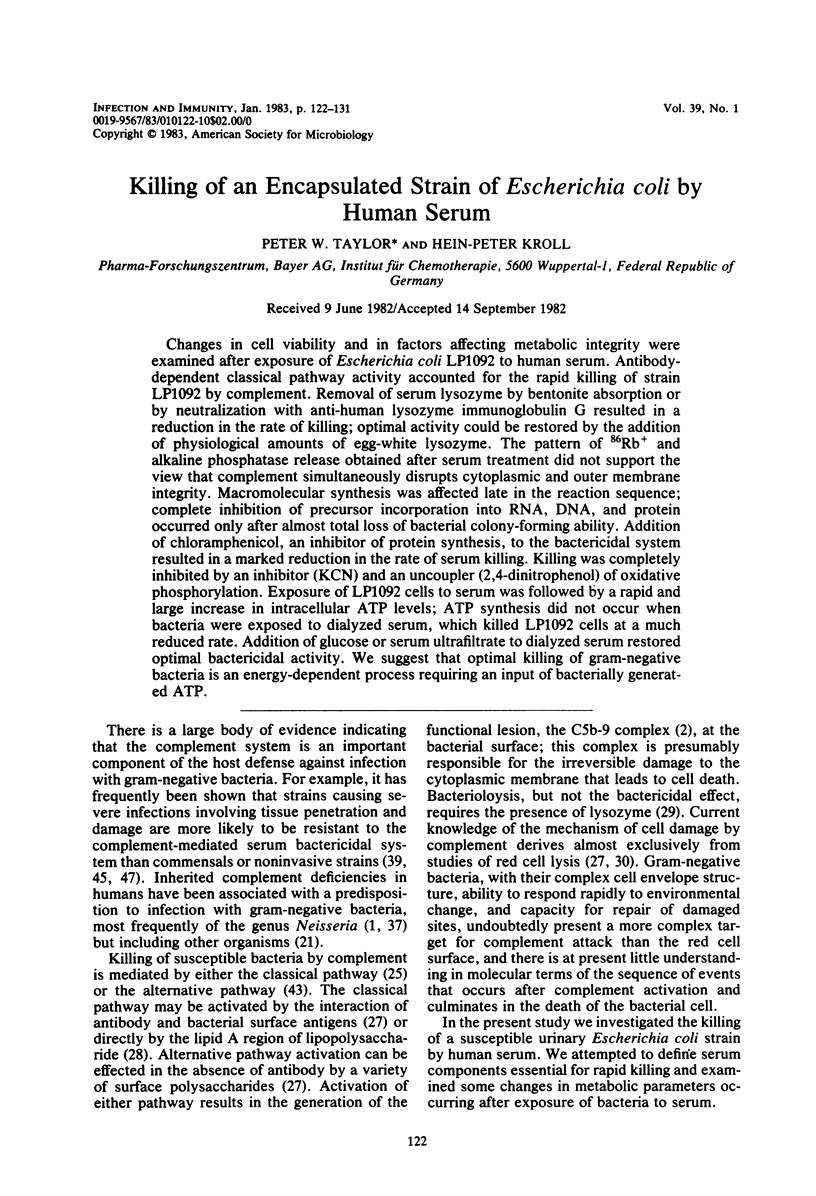
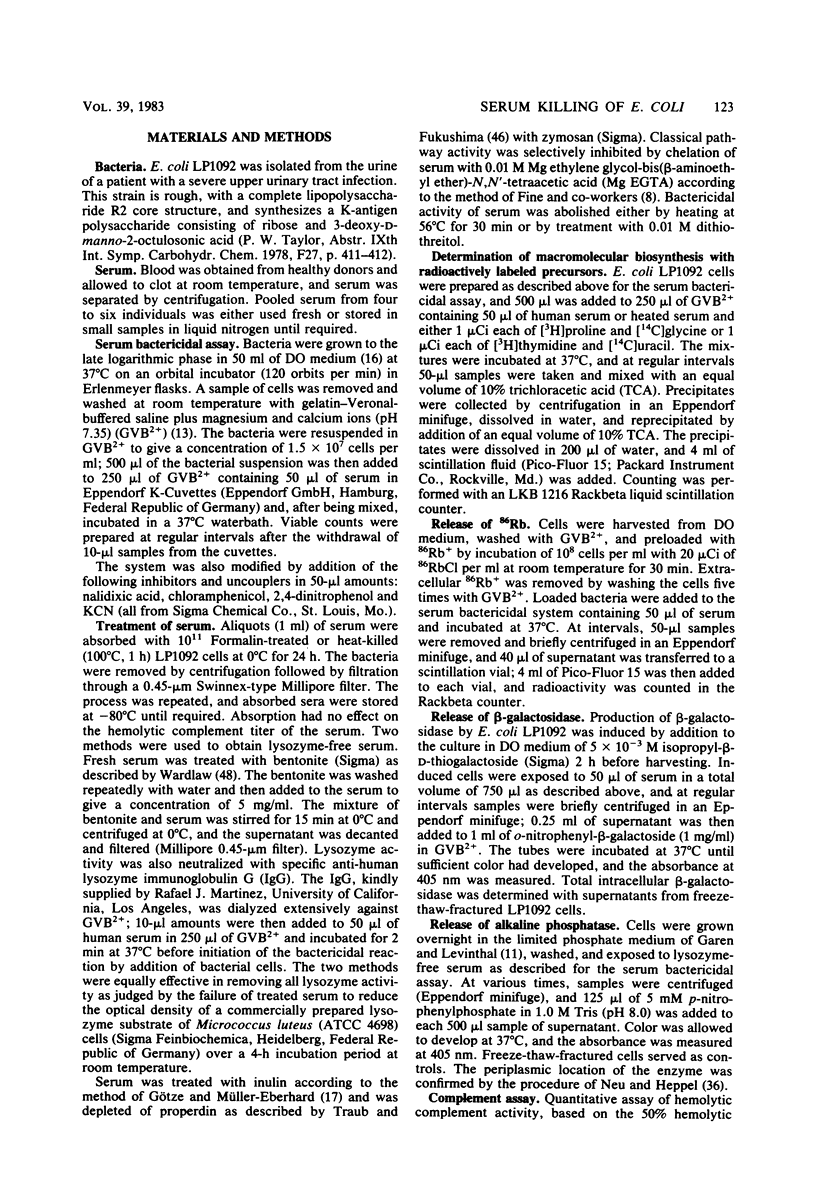
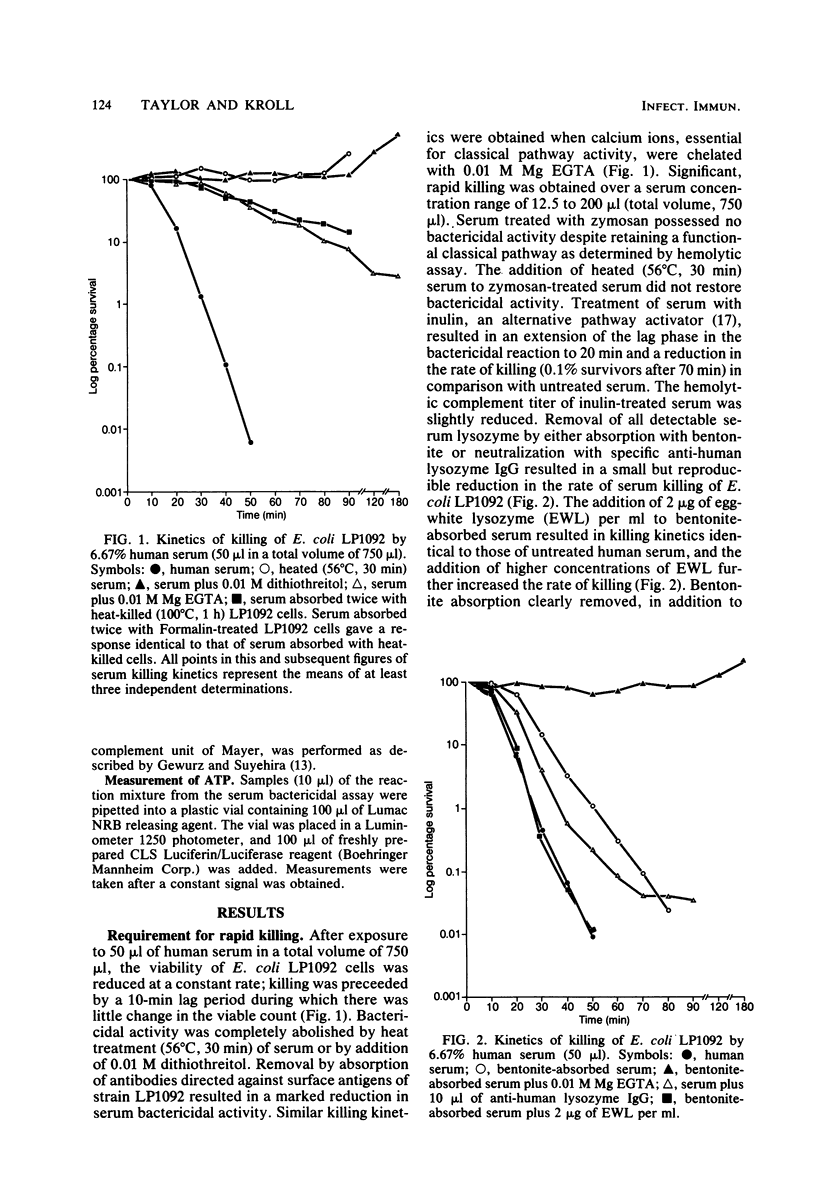
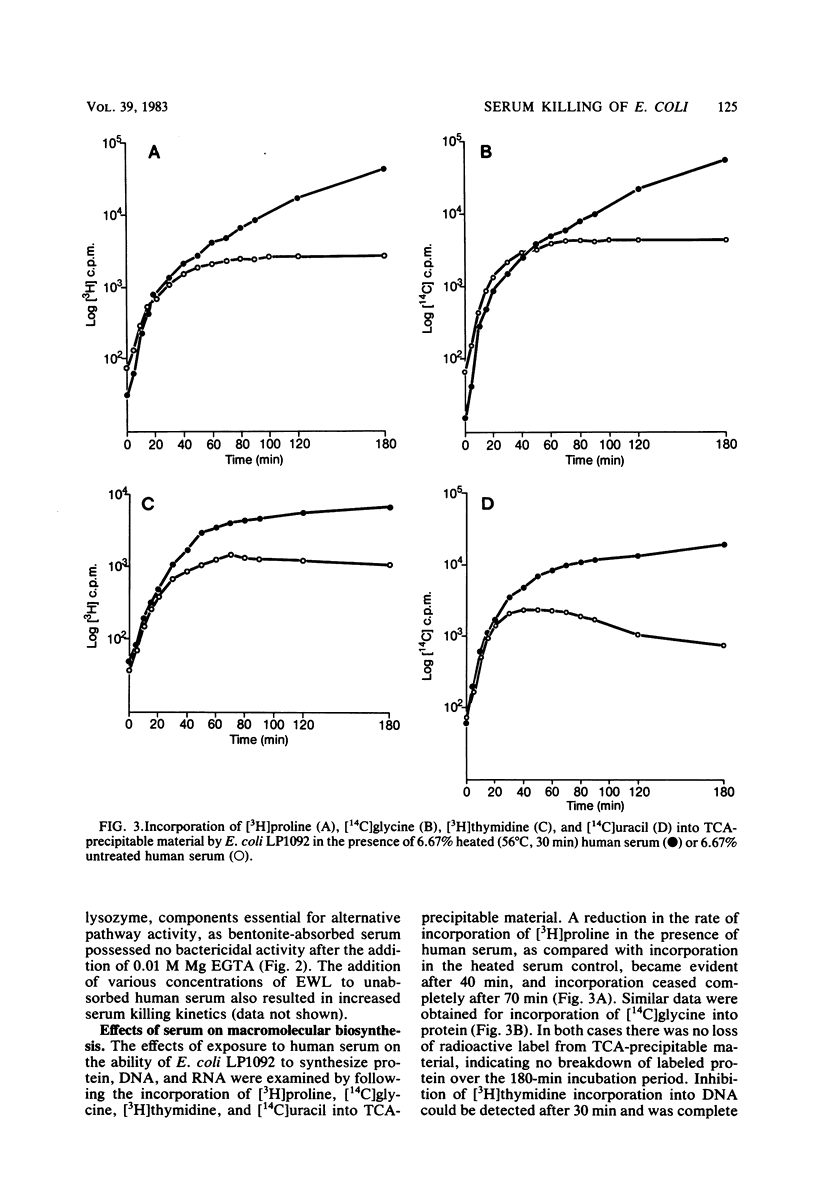
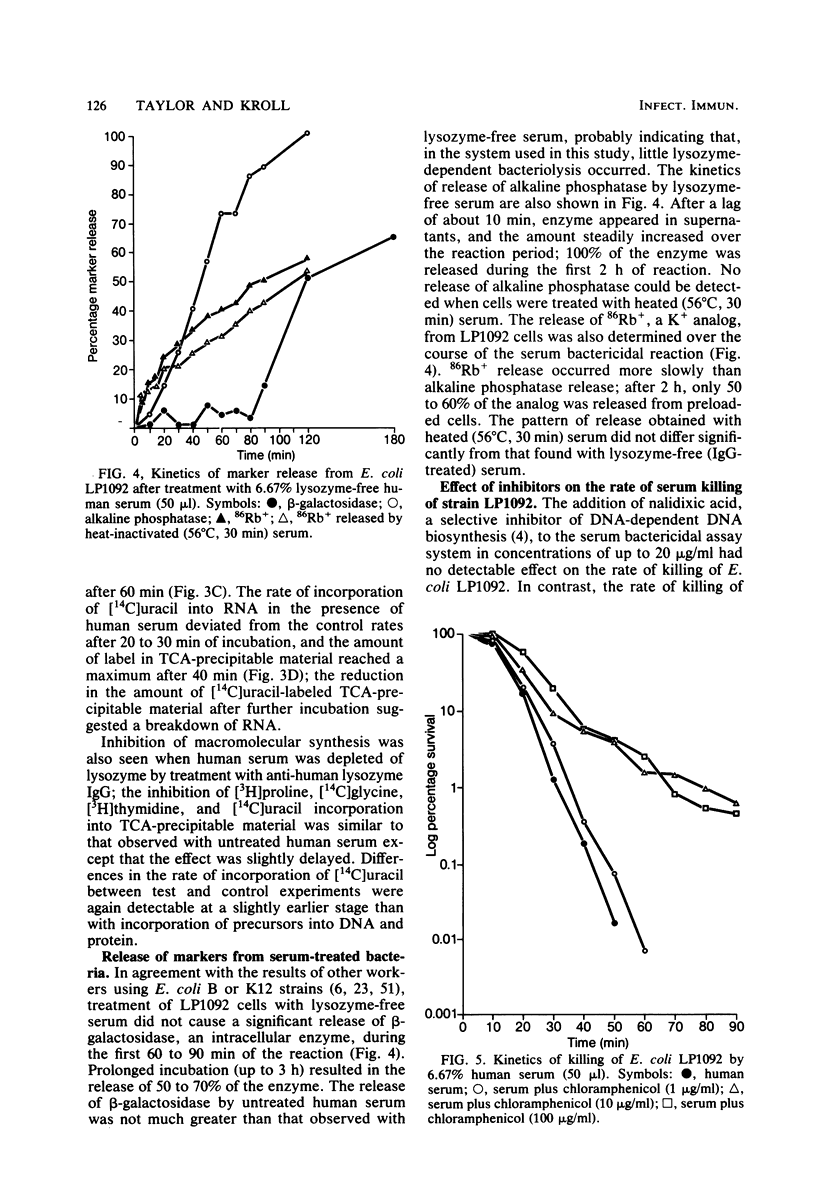
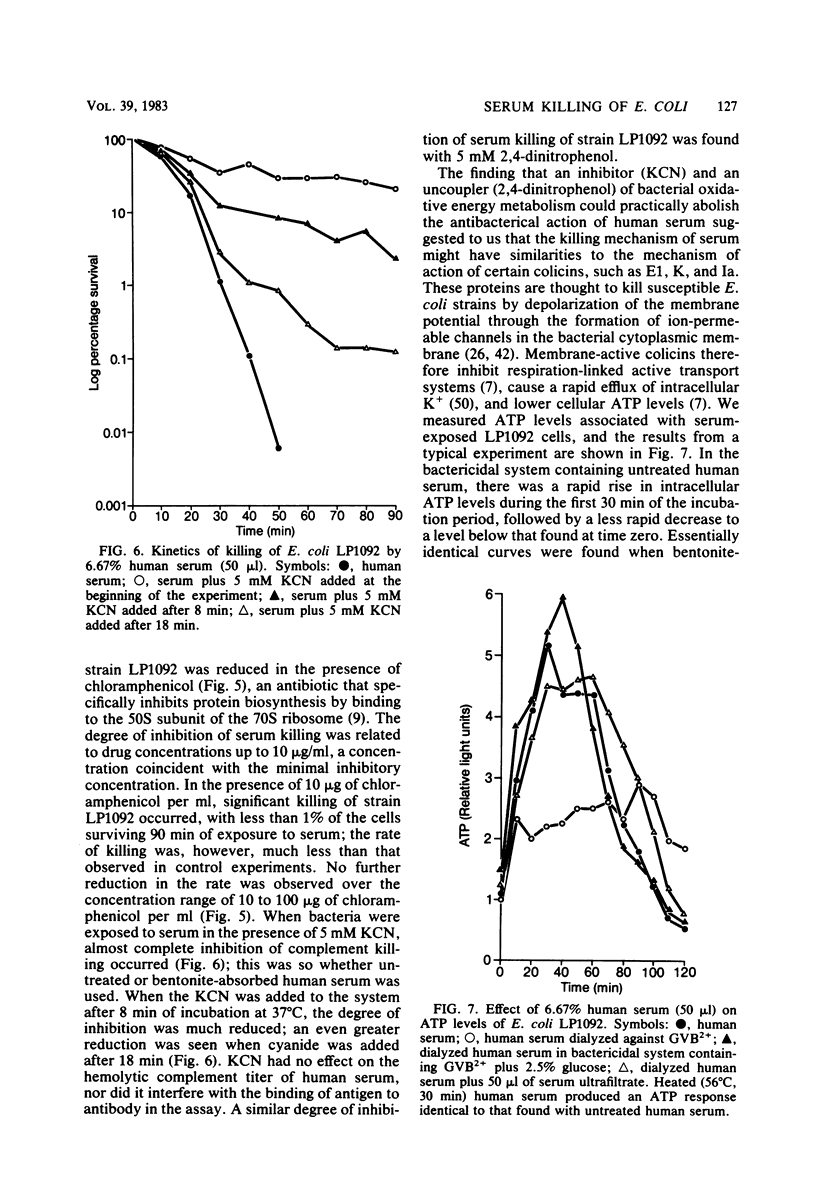
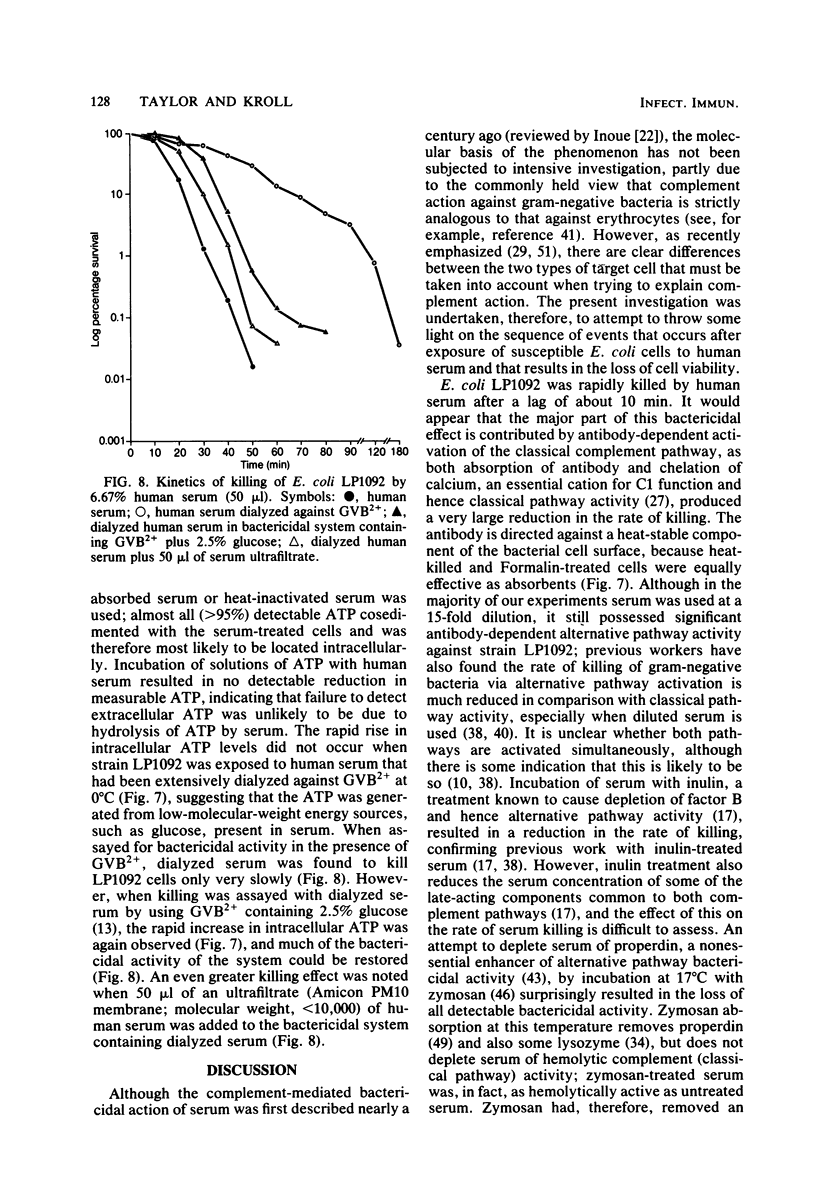

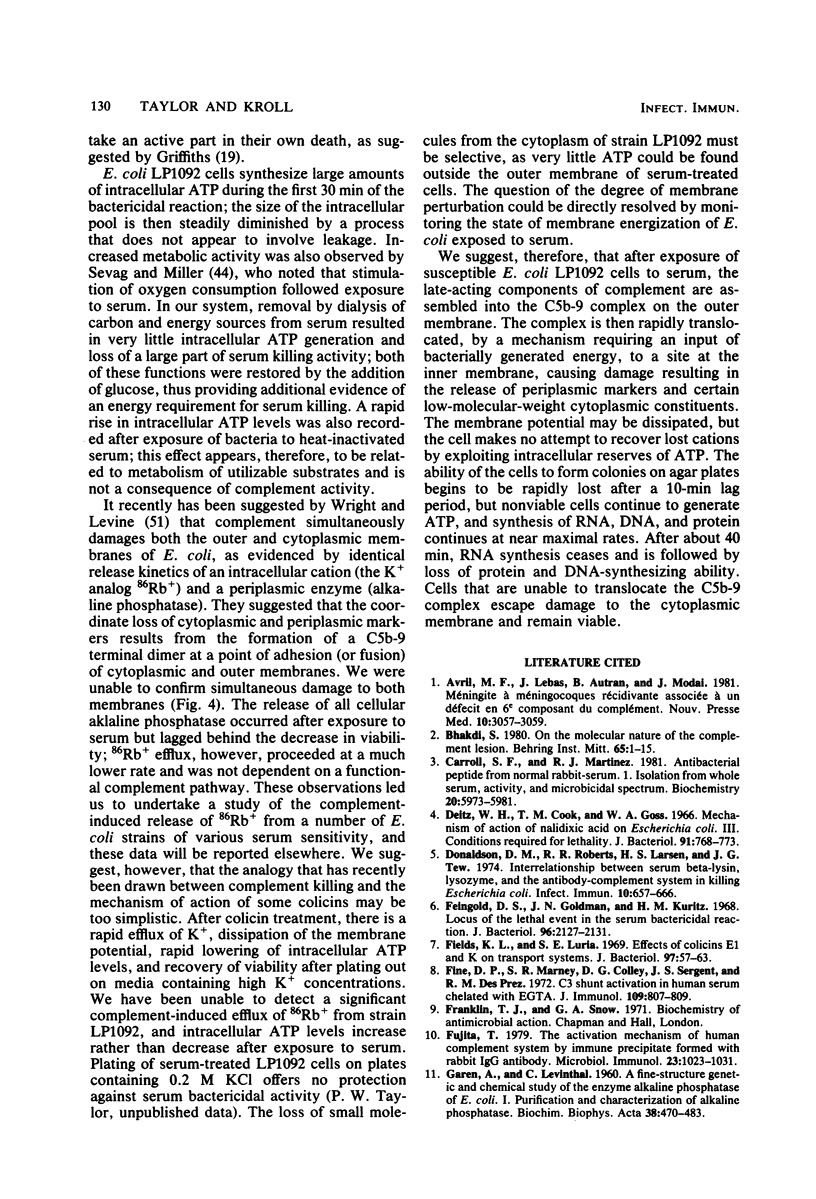
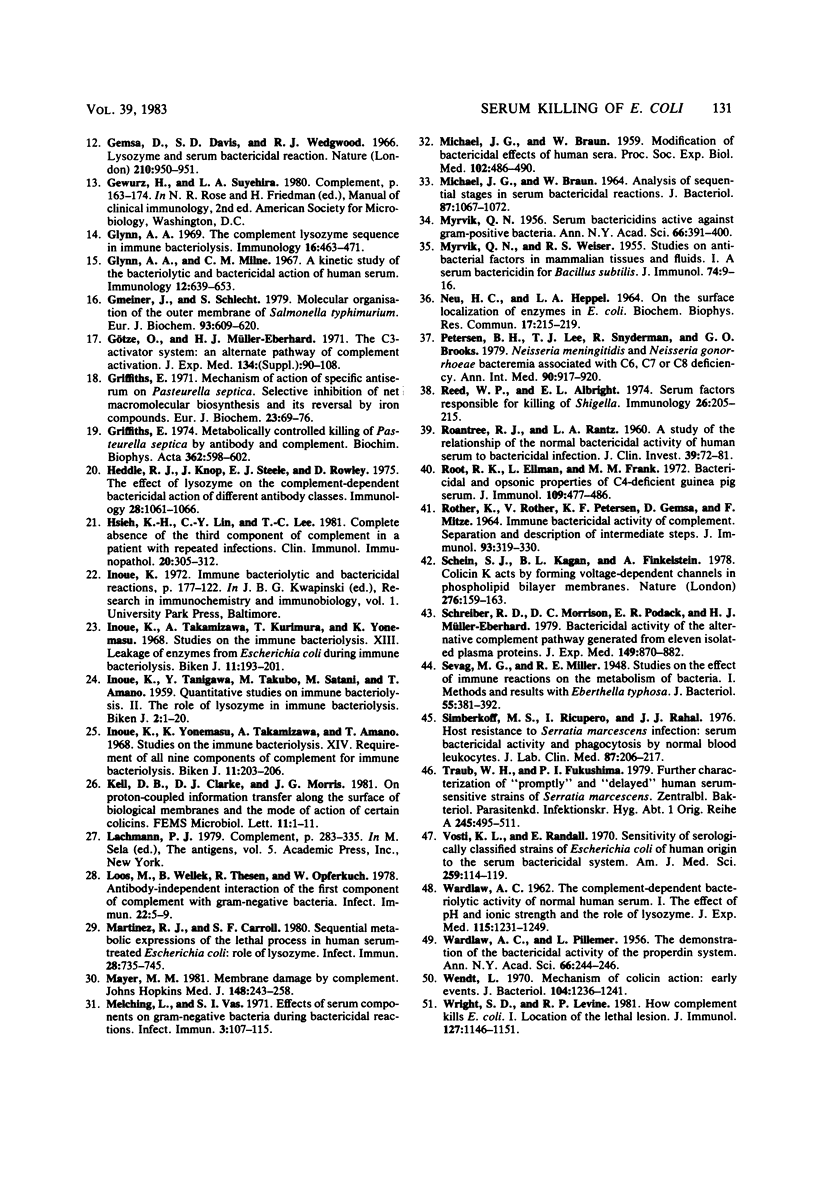
Selected References
These references are in PubMed. This may not be the complete list of references from this article.
- Avril M. F., Lebas J., Autran B., Modai J. Méningite à méningocoques récidivante associée à un déficit en 6e composant du complément. Nouv Presse Med. 1981 Oct 17;10(37):3057–3059. [PubMed] [Google Scholar]
- Carroll S. F., Martinez R. J. Antibacterial peptide from normal rat serum. 1. Isolation from whole serum, activity, and microbicidal spectrum. Biochemistry. 1981 Oct 13;20(21):5973–5981. doi: 10.1021/bi00524a008. [DOI] [PubMed] [Google Scholar]
- Deitz W. H., Cook T. M., Goss W. A. Mechanism of action of nalidixic acid on Escherichia coli. 3. Conditions required for lethality. J Bacteriol. 1966 Feb;91(2):768–773. doi: 10.1128/jb.91.2.768-773.1966. [DOI] [PMC free article] [PubMed] [Google Scholar]
- Donaldson D. M., Roberts R. R., Larsen H. S., Tew J. G. Interrelationship between serum beta-lysin, lysozyme, and the antibody-complement system in killing Escherichia coli. Infect Immun. 1974 Sep;10(3):657–666. doi: 10.1128/iai.10.3.657-666.1974. [DOI] [PMC free article] [PubMed] [Google Scholar]
- Feingold D. S., Goldman J. N., Kuritz H. M. Locus of the lethal event in the serum bactericidal reaction. J Bacteriol. 1968 Dec;96(6):2127–2131. doi: 10.1128/jb.96.6.2127-2131.1968. [DOI] [PMC free article] [PubMed] [Google Scholar]
- Fields K. L., Luria S. E. Effects of colicins E1 and K on transport systems. J Bacteriol. 1969 Jan;97(1):57–63. doi: 10.1128/jb.97.1.57-63.1969. [DOI] [PMC free article] [PubMed] [Google Scholar]
- Fine D. P., Marney S. R., Jr, Colley D. G., Sergent J. S., Des Prez R. M. C3 shunt activation in human serum chelated with EGTA. J Immunol. 1972 Oct;109(4):807–809. [PubMed] [Google Scholar]
- Fujita T. The activation mechanism of human complement system by immune precipitate formed with rabbit IgG antibody. Microbiol Immunol. 1979;23(10):1023–1031. doi: 10.1111/j.1348-0421.1979.tb00532.x. [DOI] [PubMed] [Google Scholar]
- GAREN A., LEVINTHAL C. A fine-structure genetic and chemical study of the enzyme alkaline phosphatase of E. coli. I. Purification and characterization of alkaline phosphatase. Biochim Biophys Acta. 1960 Mar 11;38:470–483. doi: 10.1016/0006-3002(60)91282-8. [DOI] [PubMed] [Google Scholar]
- Gemsa D., Davis S. D., Wedgwood R. J. Lysozyme and serum bactericidal action. Nature. 1966 May 28;210(5039):950–951. doi: 10.1038/210950a0. [DOI] [PubMed] [Google Scholar]
- Glynn A. A., Milne C. M. A kinetic study of the bacteriolytic and bactericidal action of human serum. Immunology. 1967 Jun;12(6):639–653. [PMC free article] [PubMed] [Google Scholar]
- Glynn A. A. The complement lysozyme sequence in immune bacteriolysis. Immunology. 1969 Apr;16(4):463–471. [PMC free article] [PubMed] [Google Scholar]
- Gmeiner J., Schlecht S. Molecular organization of the outer membrane of Salmonella typhimurium. Eur J Biochem. 1979 Feb 1;93(3):609–620. doi: 10.1111/j.1432-1033.1979.tb12861.x. [DOI] [PubMed] [Google Scholar]
- Griffiths E. Mechanism of action of specific antiserum on Pasteurella septica. Selective inhibition of net macromolecular synthesis and its reversal by iron compounds. Eur J Biochem. 1971 Nov 11;23(1):69–76. doi: 10.1111/j.1432-1033.1971.tb01593.x. [DOI] [PubMed] [Google Scholar]
- Griffiths E. Metabolically controlled killing of Pasteurella septica by antibody and complement. Biochim Biophys Acta. 1974 Oct 8;362(3):598–601. doi: 10.1016/0304-4165(74)90157-3. [DOI] [PubMed] [Google Scholar]
- Heddle R. J., Knop J., Steele E. J., Rowley D. The effect of lysozyme on the complement-dependent bactericidal action of different antibody classes. Immunology. 1975 Jun;28(6):1061–1066. [PMC free article] [PubMed] [Google Scholar]
- Hsieh K. H., Lin C. Y., Lee T. C. Complete absence of the third component of complement in a patient with repeated infections. Clin Immunol Immunopathol. 1981 Sep;20(3):305–312. doi: 10.1016/0090-1229(81)90140-9. [DOI] [PubMed] [Google Scholar]
- Inoue K., Takamizawa A., Kurimura T., Yomemasu K. Studies on the immune bacteriolysis. 13. Leakage of enzymes from Escherichia coli during immune bacteriolysis. Biken J. 1968 Sep;11(3):193–201. [PubMed] [Google Scholar]
- Inoue K., Yonemasu K., Takamizawa A., Amano T. [Studies on the immune bacteriolysis. XIV. Requirement of all nine components of complement for immune bacteriolysis]. Biken J. 1968 Sep;11(3):203–206. [PubMed] [Google Scholar]
- Loos M., Wellek B., Thesen R., Opferkuch W. Antibody-independent interaction of the first component of complement with Gram-negative bacteria. Infect Immun. 1978 Oct;22(1):5–9. doi: 10.1128/iai.22.1.5-9.1978. [DOI] [PMC free article] [PubMed] [Google Scholar]
- MYRVIK Q. N., WEISER R. S. Studies on antibacterial factors in mammalian tissues and fluids. I. A serum bactericidin for Bacillus subtilis. J Immunol. 1955 Jan;74(1):9–16. [PubMed] [Google Scholar]
- Martinez R. J., Carroll S. F. Sequential metabolic expressions of the lethal process in human serum-treated Escherichia coli: role of lysozyme. Infect Immun. 1980 Jun;28(3):735–745. doi: 10.1128/iai.28.3.735-745.1980. [DOI] [PMC free article] [PubMed] [Google Scholar]
- Mayer M. M. Membrane damage by complement. Johns Hopkins Med J. 1981 Jun;148(6):243–258. [PubMed] [Google Scholar]
- Melching L., Vas S. I. Effects of serum components on gram-negative bacteria during bactericidal reactions. Infect Immun. 1971 Jan;3(1):107–115. doi: 10.1128/iai.3.1.107-115.1971. [DOI] [PMC free article] [PubMed] [Google Scholar]
- Michael J. G., Braun W. Analysis of sequential stages in serum bactericidal reactions. J Bacteriol. 1964 May;87(5):1067–1072. doi: 10.1128/jb.87.5.1067-1072.1964. [DOI] [PMC free article] [PubMed] [Google Scholar]
- Neu H. C., Heppel L. A. On the surface localization of enzymes in E. coli. Biochem Biophys Res Commun. 1964 Oct 14;17(3):215–219. doi: 10.1016/0006-291x(64)90386-9. [DOI] [PubMed] [Google Scholar]
- Petersen B. H., Lee T. J., Snyderman R., Brooks G. F. Neisseria meningitidis and Neisseria gonorrhoeae bacteremia associated with C6, C7, or C8 deficiency. Ann Intern Med. 1979 Jun;90(6):917–920. doi: 10.7326/0003-4819-90-6-917. [DOI] [PubMed] [Google Scholar]
- ROTHER K., ROTHER U., PETERSEN K. F., GEMSA D., MITZE F. IMMUNE BACTERICIDAL ACTIVITY OF COMPLEMENT. SEPARATION AND DESCRIPTION OF INTERMEDIATE STEPS. J Immunol. 1964 Aug;93:319–330. [PubMed] [Google Scholar]
- Reed W. P., Albright E. L. Serum factors responsible for killing of Shigella. Immunology. 1974 Jan;26(1):205–215. [PMC free article] [PubMed] [Google Scholar]
- Roantree R. J., Rantz L. A. A STUDY OF THE RELATIONSHIP OF THE NORMAL BACTERICIDAL ACTIVITY OF HUMAN SERUM TO BACTERIAL INFECTION. J Clin Invest. 1960 Jan;39(1):72–81. doi: 10.1172/JCI104029. [DOI] [PMC free article] [PubMed] [Google Scholar]
- Root R. K., Ellman L., Frank M. M. Bactericidal and opsonic properties of C4-deficient guinea pig serum. J Immunol. 1972 Sep;109(3):477–486. [PubMed] [Google Scholar]
- Schein S. J., Kagan B. L., Finkelstein A. Colicin K acts by forming voltage-dependent channels in phospholipid bilayer membranes. Nature. 1978 Nov 9;276(5684):159–163. doi: 10.1038/276159a0. [DOI] [PubMed] [Google Scholar]
- Schreiber R. D., Morrison D. C., Podack E. R., Müller-Eberhard H. J. Bactericidal activity of the alternative complement pathway generated from 11 isolated plasma proteins. J Exp Med. 1979 Apr 1;149(4):870–882. doi: 10.1084/jem.149.4.870. [DOI] [PMC free article] [PubMed] [Google Scholar]
- Sevag M. G., Miller R. E. Studies on the Effect of Immune Reactions on the Metabolism of Bacteria: I. Methods and Results with Eberthella typhosa. J Bacteriol. 1948 Mar;55(3):381–392. [PMC free article] [PubMed] [Google Scholar]
- Simberkoff M. S., Ricupero I., Rahal J. J., Jr Host resistance to Serratia marcescens infection: serum bactericidal activity and phagocytosis by normal blood leukocytes. J Lab Clin Med. 1976 Feb;87(2):206–217. [PubMed] [Google Scholar]
- Traub W. H., Fukushima P. I. Further characterization of "promptly" and "delayed" human serum-sensitive strains of Serratia marcescens. Zentralbl Bakteriol Orig A. 1979 Dec;245(4):495–511. [PubMed] [Google Scholar]
- Vosti K. L., Randall E. Sensitivity of serologically classified strains of escherichia coli of human origin to the serum bactericidal system. Am J Med Sci. 1970 Feb;259(2):114–119. doi: 10.1097/00000441-197002000-00005. [DOI] [PubMed] [Google Scholar]
- WARDLAW A. C. The complement-dependent bacteriolytic activity of normal human serum. I. The effect of pH and ionic strength and the role of lysozyme. J Exp Med. 1962 Jun 1;115:1231–1249. doi: 10.1084/jem.115.6.1231. [DOI] [PMC free article] [PubMed] [Google Scholar]
- Wendt L. Mechanism of colicin action: early events. J Bacteriol. 1970 Dec;104(3):1236–1241. doi: 10.1128/jb.104.3.1236-1241.1970. [DOI] [PMC free article] [PubMed] [Google Scholar]
- Wright S. D., Levine R. P. How complement kills E. coli. I. Location of the lethal lesion. J Immunol. 1981 Sep;127(3):1146–1151. [PubMed] [Google Scholar]


